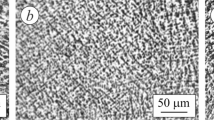An important scientific and technical problem on developing thick resistive granular films used in microelectronics and tool manufacturing is solved. Magnetoresistive Co-containing granular films are obtained by screen printing the pastes consisting of fine-grained cobalt boride Co3B and organic binder on a dielectric substrate. Then, the deposited films are heat treated in air with no protection at all. Differential thermal analysis and thermogravimetric analysis reveal that only ferromagnetic Co (FCC) and amorphous B2O3 are present in the structure of the films at T = 650–850°C. On this basis, the modes for the heat treatment of films are developed. The effect of magnetic field on the electrical resistance of films is studied.




Similar content being viewed by others
References
A. E. Varfolomeev and M. V. Sedova, “Effect of high positive magnetoresistance in weak magnetic fields of metal–dielectric nanocomposites,” Fiz. Tverd. Tela, 45, No. 3, 500–504 (2003).
O. V. Stognii, A. V. Sytnikov, Yu. E. Kalinin, et al., “Isotropic positive magnetoresistance of nanogranular composites Co–Al2O3,” Fiz. Tverd. Tela, 49, No. 1, 158–164 (2007).
V. M. Fedosyuk, A. M. Danishevskii, D. A. Kurdyumov, et al., “Magnetic properties of nickel clusters in nanoporous carbon,” Fiz. Tverd. Tela, 45, No. 9, 1667–1670 (2003).
A. I. Khachaturov, “Qualitative analysis of spin-dependent tunneling in ferromagnetic metal–insulator–ferromagnetic metal contacts,” Pis. Zhur. Eksper. Teoret. Fiz., 82, No. 10, 728–733 (2005).
A. B. Aronzon, A. E. Varfolomeev, D. Yu. Kovalev, et al., “Conductivity, magnetoresistance, and the Hall effect in granular films Fe/SiO2,” Fiz. Tverd. Tela, 41, No. 6, 944–950 (1999).
S. A. Nikitin, “Giant magnetoresistance,” Soros. Obraz. Zhur., 8, No. 2, 92–98 (2004).
S. Karpenkov, Magnetoresistive materials,” Elektron. Nauka Tekhnol. Biz., No. 8, 26–30 (2000).
V. Yudintsev, “MEMS-sensors: nanotechnologies are coming,” Elektron. Nauka Tekhnol. Biz., No. 8, 26–30 (2006).
M. Prudenziati and J. Hormadaly (Eds.), Printed Films Materials Science and Applications in Sensors, Electronics and Photonics, Wood Head Publ. Ltd, Cambridge (UK) (2012), p. 586.
B. M. Rud’, E. Ya. Tel’nikov, A. K. Marchuk, et al., “Production and properties of thick magnetoresistive films from fine Ni3B powders,” Powder Metall. Met. Ceram., 52, No. 5, 351–356 (2013).
Author information
Authors and Affiliations
Corresponding author
Additional information
Translated from Poroshkovaya Metallurgiya, Vol. 56, Nos. 3–4 (514), pp. 84–90, 2017.
Rights and permissions
About this article
Cite this article
Rud’, B.M., Tel’nikov, E.Y., Marchuk, A.K. et al. Effect Of Formation Conditions of Thick Granular Films Based on Dispersed Co3b On Their Phase Composition and Magnetoresistance. Powder Metall Met Ceram 56, 185–190 (2017). https://doi.org/10.1007/s11106-017-9885-5
Received:
Published:
Issue Date:
DOI: https://doi.org/10.1007/s11106-017-9885-5




